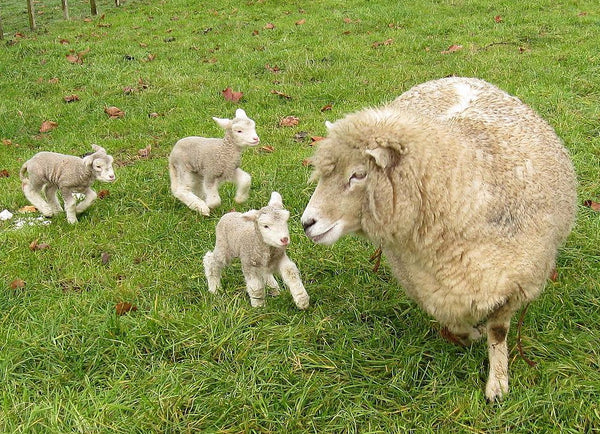Know Your Fiber: Romney Wool
Posted on May 01 2019

The tale of the Romney sheep is one of the southeastern English coast, salt marshes, and smugglers. This long-wool sheep was critical to the early English wool trade, and when the English colonized Australia and New Zealand, the Kent Romney traveled right alongside them.
The first Romneys lived in the expansive Romney Marsh in the counties of Kent and East Sussex on the southeastern coast England during the Middle Ages. Commonly referred to during this time as Romney Marsh sheep, these sheep were the ancestors of what is better known in most parts of the world as Romney sheep. A dual purpose breed used for both wool and meat, these sheep are well suited to the marshes, having developed traits that allow them to thrive in the strong winds and heavy rain of the marsh, including a strong resistance to foot rot and sheep parasites commonly found wet climates.
Romney sheep were critical to England’s dominance of the European wool market from the Middle Ages all the way up through the early 1700s. The Romney population was so large and such prolific producers of wool that their fleeces accounted for a significant amount of the wool that England exported to the rest of Europe. No taxes were collected on this wool trade between England and the continental Europe for quite some time. However, this would change around 1275 when Edward I placed the first customs duty in English history on the export of wool.
The export duty on wool started out relatively small. However, when the Hundred Years War began in 1337 the export duties began to increase substantially as a way to fund the war. As the duties on wool became ever more onerous, the shepherds of Romney Marsh and fishermen of the Kent coast quickly realized that there was substantial profit to be gained from smuggling wool and other English goods to France, and that the rewards far outweighed the risks. Thus were legendary smugglers of Kent born.
These wool smugglers were referred to as “owlers.” The source of this nickname is somewhat shrouded in history, but there are some theories as to where is originated. Somewhat romantically, one theory claims the nickname was adopted by the smugglers because they worked at night and hooted like owls as a method of signaling to each other. Another less popular, but possibly more accurate theory goes that “owler” was a corruption of “wooler,” a common name at the time for anyone in the wool business. Or, who knows? Maybe it was a bit of both.
The owlers of Kent, and neighboring East Sussex, became legendary for their exploits. What started as fisherman and shepherds supplementing their income by smuggling wool (and perhaps some tin or graphite as well) to France in exchange for luxury goods like brandy, wine, silk and tea, quickly became an industry dominated by smuggling gangs. There were all too few revenue officers available to enforce the export duties, and all too many of those appeared willing to take bribes to look the other way.
By 1614, in an effort to protect the English textile trade, the export of any wool not woven into fabric was made illegal. Although this restriction was eventually loosened, it only increased the profitability of wool smuggling during this period of time. By 1661, the English government was so desperate to regain control of the wool trade that smuggling wool was made punishable by death. Perhaps unsurprisingly, this meant that rather than stopping their trade, the smugglers decided to arms themselves. It was at this point that the smuggling gangs of Kent also began to become known for their violence. In response, customs officers were dispatched by the English government to try and stem the tide of wool smuggling. Mounted officers roamed the Romney Marsh and coast, while fast ships sailed the waters between England and France.
Apparently, though, these steps weren’t particularly effective. Smuggling wool to France in exchange for luxuries was an enormously profitable business, and officials were still all too willing to supplement their government income with a little bribe money. It probably also did not help that at times smugglers may have outnumbered the customs officials by 100 to 1. Still desperate to halt or at least reduce smuggling, the government passed a law in 1698 that prohibited anyone within 15 miles of the sea from buying any wool unless they were selling it to English buyers who were at least 15 miles away from the sea. Additionally, shepherds 10 miles from the sea (meaning, more specifically, the Romney Marsh shepherds) had to report on any fleeces sheared within 3 days after the shearing.
During the 1600s and 1700s, Romney flocks continued to grow, which meant that the availability of wool for both legal and illegal trade increased as well. The flocks on the Romney Marsh grew so large (by 1700 there were around 160,000 sheep in the marsh) that shepherds were almost completely replaced by “lookers,” – people who would look after multiple flocks of sheep owned by several owners, as opposed to the shepherds who would just look after one owner’s flock. Since the lookers had to travel quite a distance and remain with the sheep for extended periods, brick shelters known as Lookers’ Huts began to be built on the Romney Marsh. The ruins of these huts can still be found today.
Despite England’s restrictions and efforts to enforce export duties on wool, it wasn’t until late 1700s and early 1800s that wool smuggling around the Romney Marshes and the Kent coast began to wane. It was not so much due to the success of the English government as it was that England was beginning to lose its grip on the European wool market. Ireland was producing a fair amount of wool at this point in history, which could be had for cheaper and without the risks associated with smuggling. Plus, other countries were developing breeds such as Merinos that would challenge the dominance of English wool sheep breeds.
Even as England’s control of the European wool industry waned, Romney sheep maintained their importance and popularity. Romney wool still had a significant place in the textile industry for clothing and rugs, and with the Romneys’ ability to thrive in harsh and wet conditions while still providing valuable fleeces, these sheep remained a very popular breed. It addition to their wool, the sheep were also valued for their meat. It was considered such a useful dual-purpose breed that when the English arrived in New Zealand, Romney became the basis of most of their flocks.
The first sheep to arrive in New Zealand in 1853 were Romneys from Kent, followed by Merinos in 1855. However, it was the Romneys that made up much of the ovine population of New Zealand. By 1965, 75% of the sheep in New Zealand were Romneys, and although other breeds of sheep have become popular as well, Romney sheep still currently make up around 58% of the national New Zealand flock.
Today, Romney sheep can be found around the world, not just in England and New Zealand, but in many other countries including Canada and the USA. Romney sheep are also still being raised in the wet and windswept Romney Marsh on the southeastern coast of England. If you ask the locals, though, they will more likely refer to the sheep as Kent sheep rather than Romney sheep.
The Romney sheep of today have been somewhat improved upon from the original sheep of the Romney Marsh. By the 1800s, they had been crossed with English Leicester to improve on the fleece. This means that present Romney wool has an even longer staple than their earlier ancestors, with a fiber width ranging between 29-36 microns, which makes it a comfortable wool that is ideal for outerwear. Hand spinners love this wool for its ease of spinning, along with its medium luster. It takes dye beautifully, and is free from kemp.
Interested in trying out some Romney wool? Lucky for you, we have it available directly from the happy Romney sheep of England. Try out this historic wool, and see why it has remained so popular for so many centuries!
Photo by Pam [CC BY 2.0 (https://creativecommons.org/licenses/by/2.0)]

Follow US